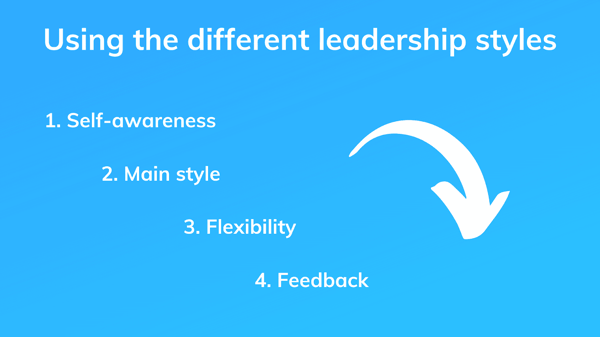

Leadership is about leading others to success while getting things done.
Even though there are many shapes and forms of leadership, researchers discovered some patterns. These patterns are called leadership styles. No matter if you’re new into leadership or already more experienced, becoming aware of these styles will enable you to become an effective leader.
In this guide, you will learn why knowing about different types of leadership styles is important, what some of the most popular leadership styles are, and how to use them for yourself. You can use this knowledge on different styles of leadership and apply it to your circumstances.
You will learn that the various leadership styles in management differ greatly from each other. Those differences characterize the impact they have on your team and how effective you are as a leader. They also suit your personality differently. You must therefore choose a main style of leadership wisely.
Knowing different styles of leadership will allow you to align your strengths, experiences, beliefs, goals, and vision with the way you lead. It will give you a perspective on your current baseline and where you have room to improve yourself. Applying leadership rules will improve team motivation, morale, stress level, communication, relationship, output, and overall impact.
Different researchers have discovered many leadership styles over the years. In this guide, we will cover the most important ones. Every style has an example of how you would engage in a typical situation. They have possible pros and cons and information on when they are best for.

As an autocratic leader, you are more of a ruler than a leader. You have complete authority over your team and the decisions being made. Team members are not encouraged to provide input because you make the decisions. There is a strict hierarchy in which you come first, and your team must follow. People often have a negative perception of this style, describing these leaders as bossy.
Example: You change the working hours of your entire team and do not ask for input on what your team wants.
Bureaucratic means that there are clear guidelines, processes, and systems that your team must follow. All of these structures are usually well-documented, and the company or predecessor defined many of them. A bureaucratic leader will make it very clear for everyone how to work and what he or she expects from the team. There is a defined list of responsibilities and how you make your decisions.
Example: Your team suggested a more efficient way to work. You checked your guidelines, but the suggestions are not within them.
Your strength is your charisma. You know how to persuade others of your ideas and opinions and your emotional intelligence is usually high. That means you understand the needs and emotions of your team very well and are truly able to connect with them. This puts you in a position where you can follow your vision, and others follow and trust you naturally.
Example: You frequently use your charisma to convince others that your ideas are the best.
The focus of this leadership style is building a great team with strong individual skill sets. Typically these kinds of leaders have had some experience with executive coaching. When applying this style, you communicate with your team members very often. You want to figure out how your team can work together at its best. The expectation is that you want people to try new things and develop themselves to unlock their potential. You see yourself as a leader who can push them in the right direction rather than just providing tasks.
Example: You frequently have one-on-one sessions with a focus on the growth of the individual.
In this style of leadership, the key is that the opinion of your team matters. You encourage ideas and opinions of every team member, and they matter equally. In the end, you may make decisions altogether in the group, or you keep the final call by yourself. Open communication is a key factor, and everyone should feel part of the team.
Example: Whenever you have to make an important decision, you schedule a team meeting first.
With this style of leadership, you encourage your team to use the freedom to figure things out themselves. Once you set a goal, you try to stay out of the way and come in only when needed to solve issues. Sometimes you do not even set goals or step in. Instead, you may let the team solve problems themselves. As this kind of leader, you rather see yourself as the person who is just pointing the team towards a vision or goal.
Example: Your team solely decided to work on a specific task. You weren’t involved in the decision-making process. You’re aware of the task they’re working on and monitor only.
While your team is there to serve the company, you are there to serve your team. You see your main job in solving your team's problems and making sure your team has everything they need to work productively. On the other side you focus is not on unlocking potentials. You prioritize the needs of your team and put your own needs in the second position.
Example: You always ask your team members how you can help and put your efforts into removing obstacles.
In the transactional leadership style, achievements and failures play a central role. Everyone knows what needs to be done, why that needs to be done, and to what standard. You reward your team members for doing precisely the work you expect them to do. On the other hand, you punish team members if they don’t fully meet the expectations you set.
Example: You talk to your team and ask detailed questions to figure whether everyone is on track and punish them if by rejecting days off.
The transformational leadership style is about getting out of the comfort zone. First, you set clear goals that your team members need to achieve. Over time, you keep setting higher goals. While you do so, you encourage everyone to find better ways to do their job and to challenge the status quo. In this style, mission and vision play a key role.
Example: When you notice your team is just doing fine, you already think of what you can change to improve.
The visionary leadership style is also called authoritative leadership style. As a visionary leader, you constantly spread your vision, and you take time explaining your thinking often. Your focus is not on giving instructions. You preferably want team members to follow you, and you lead by example. Furthermore, you have a clear understanding of what challenges you must overcome to reach your vision.
Example: You repeatedly talk about the vision of the company and its impact on the current status quo.
The styles of leadership show how you can act and interact with your team members. However, there are different individuals, situations, goals, and companies. In a practical world, choosing one leadership style and sticking to it all the time, will make you a less effective leader. In order to be a super-effective leader, the following five steps enable you to get the most out of the concept of leadership styles.

First, you need to know yourself, with all your strengths and weaknesses. This will help you to match your behavior with the leadership styles. By comparing yourself with the different styles, you will figure out which ones suit you more naturally and which don’t.
Even though you have to jump between leadership styles, it’s crucial that you have one main style of leadership. Especially for the sake of consistency. After assessing yourself in step one, use the results of the assessment, and choose your main leadership style.
This step might be the most critical one. To maximize your leadership effectiveness, do not stick to your main style in each situation. Be aware of the pros and cons of each style and for what you can use them best. Then pick the one that you need for a given situation.
Directly asking others what impression you make on them is one of the best ways to figure out how well you genuinely accomplish your leadership style goals. You can ask your mentors, managers, and even your team members for feedback.
Outstanding leadership comes in many ways. Nevertheless, there are some patterns to categorize different styles of leadership. If you manage to leverage these styles for your leadership success, you will recognize positive changes within your team.
Increased motivation, trust, higher productiveness, and greater satisfaction are just some things you can improve. Make sure not to stick with one style all the time and adapt your style as the situation requires. Stay authentic to who you are. Others will recognize if you don’t.
Email is one of the go-to forms of communication for many companies who want to connect with...
 by Michael Bibla
by Michael Bibla
You can distinguish between B2B vs. B2C marketing, but in the end, you must market for H2H:...
 by Axel Kuehnle
by Axel Kuehnle
Solutions often meet us at intersections.
 by Nanditha Vijayaraghavan
by Nanditha Vijayaraghavan
Email is one of the go-to forms of communication for many companies who want to connect with...
 by Michael Bibla
by Michael Bibla
You can distinguish between B2B vs. B2C marketing, but in the end, you must market for H2H:...
 by Axel Kuehnle
by Axel Kuehnle
Never miss a post.
Subscribe to keep your fingers on the tech pulse.


